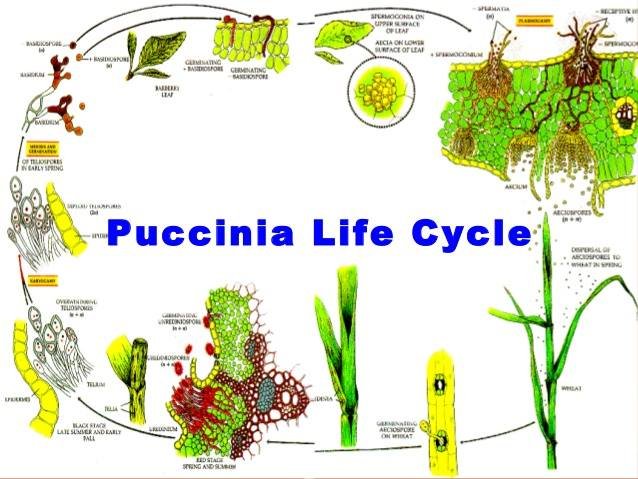Life cycle of Puccinia Graminis Tritici

Puccinia graminis is the member of fungi.It has many species which are obligate parasite on a wide variety of host.It commonly effects the plant of wheat and also effects many other species of grasses such as oat, barley and rye etc.The fungus completed life cycle on two different hosts and known as heteroecious rust.There are five stages present in the life cycle of puccinia which are uridinial stage, talial stage, basidial stage, pycenial stage and asial stage.First three stages present in wheat plant and effect the barberry plant while the last two stages produce in the barberry plant but effect the wheat plant.
Taxanomic position.
Kingdom: Fungi
Division: Amastigomycotins
Sub-Division: Basidiomycotina
Class: Basidiomycetes
Order: Uredinales
Family: Pucciniaceae
Genus: Puccinia
Species: P.graminis
Life cycle on wheat plant
Puccinia graminis mostly effects the wheat stem causing the black stem rust.The first sign appears early in march in the form of elongated radish brown granular sori.These sori are known as uredosori.
- Uridinial stage
The uredospores are one celled, two nucleus, some what globose, slightly thick walled spores.These spores formed on the stalk.The spores exert pressure on the underlying epidermis causing breakdown of the host epidermis to form uridinia and this stage is known as uridinial stage.
Dispersal of spores:-
The spores are dispersed by wind and logged on the wheat plant.
Germination of spores:-
The spores germinate within few hours after falling on the wheat plant.It germinate by the formation of germ tube.The germ tube reaches the stomata and tip swells into the vesicle called appresorium.Then the cytoplasm along with nuclei migrates into the appresorium, which is then cut off by the formation of septum.
Production of Uredospores:-
Numerous hyphae are produced underlying the epidermis and new uredospores are produced. These spores exert pressure on the underlying epidermis and sorous is exposed and postules are produced. - Telial stage
At the end of growing season the color of uredosori changes and become dark brownish to dark reddish or rusty.This color is due to the production of new spores called as tleto spores.These spores are two celled binucleated slightly oval in shape and thick walled.The spores are oval with tapering ends.Each cell of spore has two nuclei and one germ pore.
Dispersal of teleutospores:-
These spores are dispersed by wind and do not germinate in unfavorable conditions.They decrease their metabolism ability till conditions are unfavorable for germination. - Basidial stage:-
On germination each teleutospores produces germ tube known as pro-mycelium or epibasidium.The two nuclei fused together to form diploid nuclei.Four haploid nuclei are produced after meiosis.Then the cytoplasm along with nuclei migrates into the promycelium.It divided into four cell and form septum.Each contain one cell.Each cell forms a lateral strigma.The basidiospores are produced on strigma which are one celled and one nucleated.
Life cycle on Barbary plant
Basidiospores are unable to infect the wheat plant while it infect the alternative host Berberis vulgaris.
Germination of basidiospores:-
When the spores logged on the leaf surface they germinate by producing a short germination tube.The tube enters the epidermal cell.The hyphae grow in each direction and remify the mesophyll tissues.The hyphae are intercellular and obtained food by sending historia in the cell. - Pycnidial stage
The mycelium produced by germination of basidiospores is monokaryotic.It forms the small knots just below the upper epidermis. Then these cell are transformed into flask shaped cavities called spermatia.These are open to side by a small aperture called ostiole. The spermatia released by the ostiole in a mucilage liquid.They are dispersed by wind.
Dikaryotization:-
When a spermatium becomes attached to the receptive haphae of the opposite sexual phase its nucleus enters the receptive hyphae of the opposite sexual phase. - Aecial stage:-
In receptive hyphae the nucleus of the spermatium divides several time and the daughter nuclei migrate to the other nuclei.As the spores are mature the wall of the peridium rupture and cup shape structure known as acedium.
Germination of Aeciospores:-
These spres do not attack the barberry plant nut they can only infect the wheat plant.